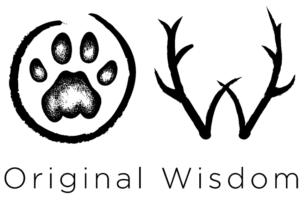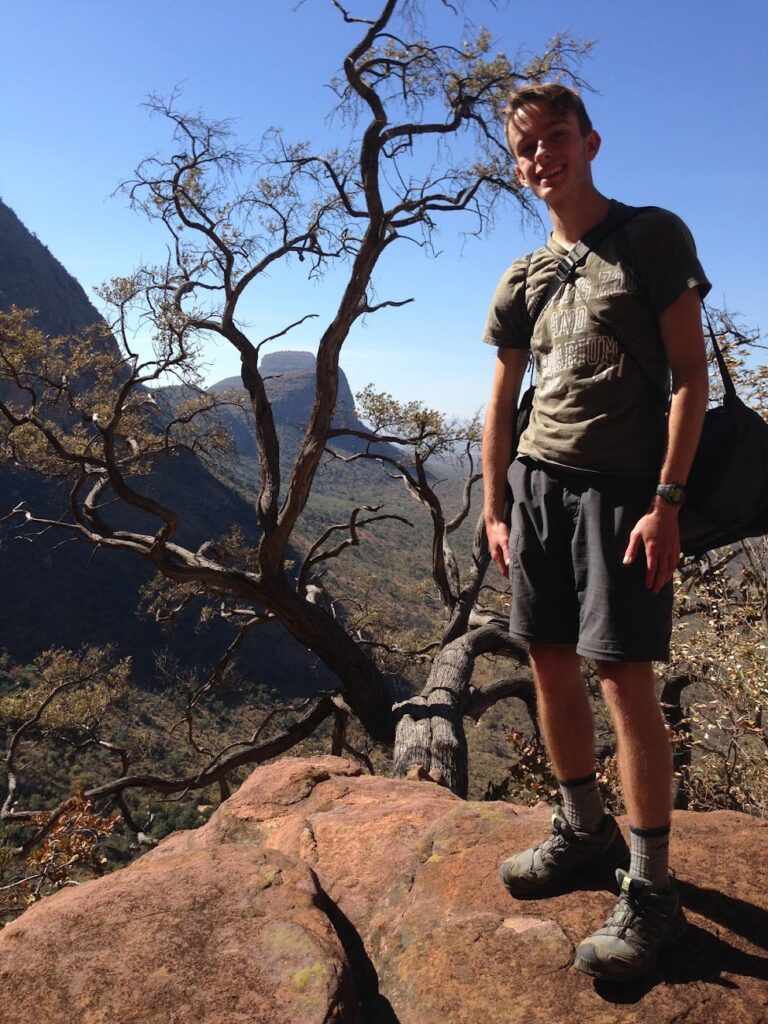The Big Five on the Fourth of July! – Hopkinton/Bow Student Blog #6
The following blog post is created by a Hopkinton/Bow High School student from New Hampshire, who is on program with Original Wisdom, partnering with Nature Guide Training, on a 3-week South African Ecology & Culture program at Djuma Game reserve in the Sabi Sands region of the Greater Kruger Area (July 2015). In addition to exposure to ecology and culture, we have sponsored a local South African student on scholarship for the entire program (see Blog 3# Interview with Mhlavasi) and will attend 2 days at Mhlavasi’s school, Acorns to Oaks, where our students interact with the local students and help to teach them some basic skills in spatial thinking and use of Geographic Information Systems (GIS) to create online maps and stories with a spatial component. Our overall goals include facilitating connections with self, others, and the natural world.
Zach Drotos
4 July 2015
Day 3
The fourth day of the seventh month holds significance in the eyes of every American. It is the day our great nation gained our independence from England, hence, it is called Independence Day. Magnificent displays of fireworks, bar-b-ques, and gatherings of people are held across the USA – these can be seen from almost every lawn of every house in America. This Independence Day, the fourth of July, I found myself in celebrating with an early morning wake-up and a game drive in beautiful South Africa. Although we did not get to look in awe as fireworks sprayed vibrant colors across the night sky, myself and the other student from New Hampshire were blessed with a spectacular and multicolored African sunrise.
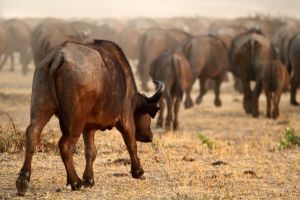
This morning, Kersey was our guide and Lee our tracker. We headed first toward the northwest corner of the reserve to an area called Sydney’s Dam. Almost ten minutes into our “bumble” (a slow and spontaneous drive) the first species of the infamous Big Five showed itself to us in the form of an enormous herd of Cape Buffalo – probably 300 to 400 animals, cows, bulls, and youngsters coming out of the brush into the open and making their way to the dam to drink. Acima and the other half of our group joined us shortly and we all found ourselves completely surrounded by these massive creatures. After the majority of the herd passed us, a few “dagga” boys came into view. Dagga means “muddy” and these are the old and cantankerous males that often splinter off of the herd to live out the remainder of their lives asocially or in small bachelor herds, wallowing in mud day-after-day to cool down and to remove parasites. By joining forces these self-determined “exiles” are able to increase the survival rate of each other – a neccesity because they are a favorite prey species for lions. One massive dagga boy limped by, favoring his hind left leg. In his struggle to keep up with the herd, he would probably soon fall behind. Another two dagga boys somehow became entangled in their amble over the road, with one hooking his front leg into the massive curving horns of the animal next to him. They almost patiently stopped in their tracks while the one removed his leg from the other’s horns and the ambled on after the herd together. There were a lot of other vehciles out; it was a weekend and business was pumping in the Sabi Sands. We sat with the buffalo for a while and then, out of courtesy, left the sighting to make space for some eager tourists. Kersey heard something interesting on the radio, and excitedly spoke a few words of the local Shangaan radio lingo to Lee, who seemed to also get excited and said we would head there “just now.” Kersey called in on the radio and was granted a standby permission to pull into the “mfazi ingwe loc.” We headed south, into the heart of Djuma.
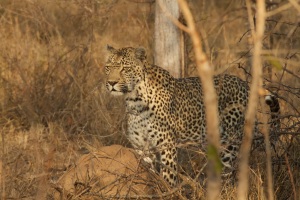
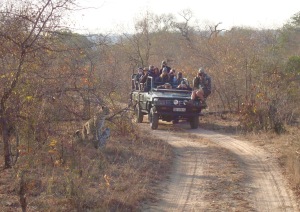
After traversing several turns in the sand roads, we found ourselves driving off road into the middle of a “block”, carefully over shrubs and small trees that sprang back into position after we passed, while constantly leaning into the vehicle, dodging long acacia thorns. Several exhilarating offroading moments later we realized that Lee and Kersey had not abandoned our search for the leopard, when, about twenty feet in front of us the distinct rosettes of a leopard materialized as she strolled confidently towards our vehicle and posed on a fallen log! My heart began to beat faster as I was on the edge of my seat, trying to get a better view of this majestic feline. She walked right in front of our vehicle, paying us no attention (ignoring us like only cats can do) and we followed her, winding among the trees to find the best path for our large vehicle that would damage the bush the least. When we finally arrived back at a sand road we relized she was hunting! Someone spotted a group of impala to our right, opposite the leopard. With our vehicles providing some form of barrier, the female leopard decided to try her luck with this group of Impala. However, the wind was not in her favor. The wind pushed her sent towards the feeding Impalas. Most of them carried on with eating, however some became alert, scanning the area for danger. We stayed as long as possible in the sighting, watching her crouching beside a large termite mound… but she dipped down into a “donga” a dry, eroded riverbed to try and get around the wind, where we could not folow and could not view her – the hunt could take a long, long, time and we did not want to ruin it for her… so we bumbled on.
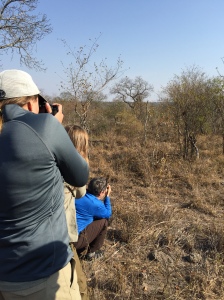
Kersey heard about an “nglovu” sighting on the radio and we headed northeast. We stopped to watch some dwarf mongoose sunning themselves on a termite mound and then thought he heard the classic sound of breaking branches of feeding elephants, our nglovu. He grabbed a hand-held radio and headed into the block on foot to locate them. After a few minutes he radioed something to Kersey and she asked us all to get off the vehicle and follow her, single-file, and queitly, into the bush. Lee had stumbled into a group of three sleeping white rhinoceros, and we moved very quietly toward them, to within 20 meters, watching their ears swing back and forth as they listened to the bush around them, sides gently rising and falling with breathe as they slept – truly sleeping giants. Everyone took pictures, and after the paparazzi had settled down, we left the rhino unaware that we had ever been there and Kersey led the way back to the vehicle while Lee brought up the rear of the column.
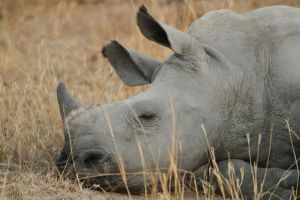
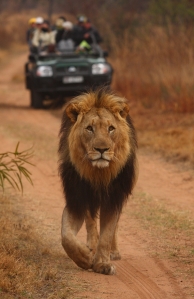
It was getting toward late morning by that time, almost 10 am and our stomachs began to rumble in anticipation of brunch – but Kersey had other ideas. We took the long way back to camp, swinging down to the extreme south of the reserve and making our way slowly north again on a particularly chosen road. She was speaking to the other guides on the radio about “ngala” at Twin Dams – and that’s where we headed. When we pulled up to the dam, a huge male lion with a big black mane strode out of the bush right in front of us and proceeded to scent mark and rub on the magic guarri bushes and the began roaring, or “kala’ing” right beside our vehicle before striding back into the bush! The sound reverberated through our bodies. After sitting for a few minutes to get over the shock, we headed back to camp for brunch. Already, in one four hour morning drive, we had seen four of the infamous Big Five of Africa – we only needed to see the elephants that had eluded us earlier to complete the collection! Kersey joked that it was custom to shave our heads if we saw the Big Five in one game drive, so she hoped that the nglovu would wait to make an appearance.
After brunch, we spent some time journaling and worked on our group projects, took some personal time for hot showers, naps, and conversations, then we loaded ourselves back onto the “movas” (slang for mover, or vehicle) for our evening adventure.
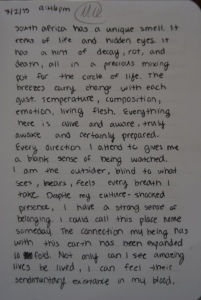
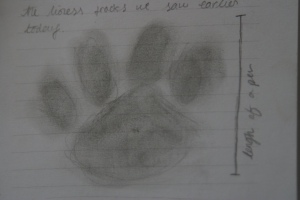
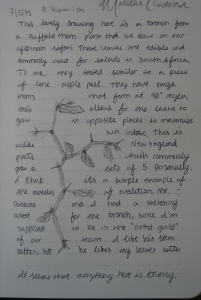
Diana and Acima took us on the evening game drive, finding a set of lion tracks almost immediately and following them in the beautiful sand roads. Our search was made easier when we heard of an ngala sighting over the radio. Diana quickly responded to the announcement and asked to join the “loc” or location. Shortly thereafter we found ourselves parked not fifteen feet away from a sleeping male lion. Thirty feet beyond the male lion was a lioness with her three young cubs! Our other mova joined us in the sighting and everyone in the group had an opportunity to view and photograph baby lions!
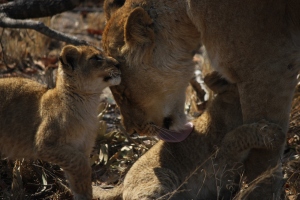
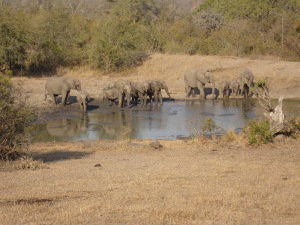
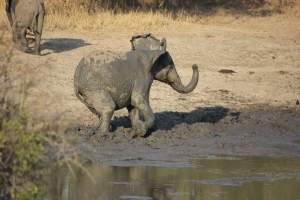
Within three minutes of leaving the lions, we bumbled into a group of elephants in the watering hole at Twin Dams. There must have been at least fifteen elephants of all ages. To explain, the watering hole was not much of a watering hole, rather a water and mud hole. The elephants did not hesitate to roll around in the brown, smelly gunk. After drinking, playing, and many mud baths later, the elephants began to move across the road, past us and to the other side of our mova. We pulled closer to their crossing point and even more elephants presented themselves to us out of the bush. I counted aproximatly fifty elephants! As we drove along the road, the vehicle became engulfed in the herd of elephants. Some were so close to us that if you reached your armout you could touch them! All in all, it was not to shaby Fourth of July; while I originally thought I might miss having a bar-b-que and a fireworks display, seeing all of the big five in one day, another spectacular African sunset, and tons of little things along the route was an amazing substitute!
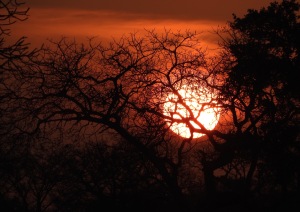
Edited by Kersey Lawrence
